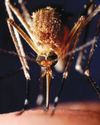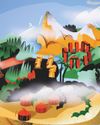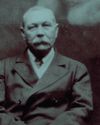When conditions are right, Australia’s wild budgerigar populations explode and form gigantic super-flocks – a far cry from a talking parakeet in a cage. Helen Pilcher investigates.

At first it was quiet. In the heart of the Australian outback, the waterhole lay silent and still; an undisturbed oasis in the vast expanse of scorched, terracotta earth. All around it the unforgiving desert stretched as far as the eye could see, peppered only with the occasional parched shrub or straggly coolabah tree. Then, as the sun began to rise, it appeared as if from nowhere.
In the distance, cutting through the early morning haze like a twisting gymnastics ribbon, a strange cloud rose and fell, twisted and turned, casting a series of sinuous silhouettes against the cloudless sky. Ever-changing, never still, the bizarre shape-shifter danced its way out of the distance towards the waterhole. As it came closer, the blue sky turned green, and the amorphous mass resolved into the tiny bodies of hundreds of thousands of colourful birds. They wheeled wildly, screeching chaotically. The collective beating of a million wings was almost deafening.
Sitting quietly near the water’s edge, naturalist and wildlife photographer Roland Seitre found himself immersed in one of nature’s most impressive and under-appreciated spectacles; a super-flock of wild budgerigars. “I was totally surrounded,” he says. “I was in the flock. There were birds maybe a metre away from me, but they took no notice at all. The air was electric.”
When we picture budgies we tend to think not of wild birds but of captive companions. They are the world’s third most popular pet after dogs and cats, best known for chomping on cuttlefish ‘bones’, their cheeky, loquacious nature and their rhetorical enquiries, such as “Who’s a pretty boy then?”. But this highly social species is native to Australia, where it can be found flying wild and free across most of the continent.
This story is from the September - October 2019 edition of BBC Earth.
Start your 7-day Magzter GOLD free trial to access thousands of curated premium stories, and 9,000+ magazines and newspapers.
Already a subscriber ? Sign In
This story is from the September - October 2019 edition of BBC Earth.
Start your 7-day Magzter GOLD free trial to access thousands of curated premium stories, and 9,000+ magazines and newspapers.
Already a subscriber? Sign In

World's First Malaria Vaccine
The World Health Organization’s director-general hails ‘historic moment’ as mass immunisation of African children begins

Is River Pollution Putting The Species In Jeopardy Again?
Ten years ago, it was jubilantly announced that o ers had returned to every county in England. But is river pollution putting the species in jeopardy again?

The Big Burnout
Long hours, low pay and a lack of appreciation — among other things — can make for a stressful workplace and lead to burnout. It’s something we should all be concerned about, because over half of the workforce reports feeling it

Putting Nature To Rights
More countries are enshrining the right to a clean environment into law. So if a company or government is impinging upon that right, you could take them to court

Mega Spaceship: Is It Possible For China To Build A Kilometre-Long Spacecraft?
Buoyed on by its successful Moon missions, China has launched a five-year study to investigate the possibility of building the biggest-ever spacecraft

Are We Getting Happier?
Enjoying more good days than bad? Feel like that bounce in your step’s getting bigger? HELEN RUSSELL looks into whether we’re all feeling more cheery…

“Unless the Japanese got the US off their backs in the Pacific, they believed they would face complete destruction”
Eighty years ago Japan’s surprise raid on Pearl Harbor forced the US offthe fence and into the Second World War. Ellie Cawthorne is making a new HistoryExtra podcast series about the attack, and she spoke to Christopher Harding about the long roots of Japan’s disastrous decision

Your Mysterious Brain
Science has mapped the surface of Mars and translated the code for life. By comparison, we know next to nothing about what’s between our ears. Over the next few pages, we ask leading scientists to answer some of the most important questions about our brains…

Why Do We Fall In Love?
Is it companionship, procreation or something more? DR ANNA MACHIN reveals what makes us so willing to become targets for Cupid’s arrow

Detecting the dead
Following personal tragedy, the creator of that most rational of literary figures, Sherlock Holmes, developed an obsession with spiritualism. Fiona Snailham and Anna Maria Barry explore the supernatural interests of Sir Arthur Conan Doyle